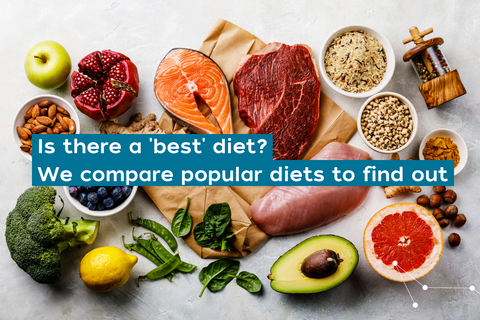Let’s talk about “diets”
Diets can be defined as the sum of food consumed by a person and often implies the use of specific intake of nutrition for health or weight-management reasons. Over the years, the term “diet” has formed negative connotations potentially associated with disordered eating, body image and mental health issues. Importantly, the quantity and quality of food ingested helps determine how healthy or effective a diet is likely to be.
Some individuals may follow a diet purely for weight-loss reasons, and no matter the type of diet, the only way for this to be successful is to reduce the average daily caloric intake below what is typical or habitual. It is important that these methods of calorie restriction do not contribute to malnutrition or deprivation of essential nutrients. Other individuals might follow a 'diet' purely for ethical, nutritional or health-related reasons. For example, following a vegan or purely plant-based diet; going gluten-free due to coeliac disease; or choosing whole-food diets (e.g. Mediterranean diet) to improve overall health.
Hundreds of different diets have gained popularity over the years, creating hype, sparking intrigue and in some instances, proving very successful in weight loss and weight-management.
In this article we will delve into some of the most popular diets that have gained interest in recent years, however before we get into the details and science behind these diets, let’s look back on some of the interesting and popular fad diets that have swept through the globe over the past 100 years!
- The Cigarette Diet - A cigarette company in the 1920’s called Lucky Strike, campaigned the use of having a cigarette instead of eating real food. It’s slogan, “Reach for a Lucky instead of a sweet”, focused on tobacco’s ability to suppress one’s appetite.
- The Grapefruit Diet - also referred to as the ‘Hollywood Diet’, the grapefruit diet originated in the 1930’s and involved eating grapefruit or drinking grapefruit juice with every meal. The theory was that citrus fruits contained enzymes that helped to burn fat (unfortunately this diet was not back by science!).
- The Master Cleanse - the original liquid diet combination of hot water, lemon juice, maple syrup and cayenne pepper was started in the 1940’s by Stanley Burroughs and rose to popularity in the 2000’s after Beyonce selected this diet to assist her to lose weight for her movie “Dream Girls”. Stanley claimed the liquid cleanse was a healthy and natural way to flush the body of deadly toxins, pesticides and other impurities.
- The Cabbage Soup Diet – this involved promoting rapid weight loss by eating cabbage soup with small amounts of fruit, vegetables and meat, in a single week. The origin of this diet is largely unknown however it gained popularity in the 1980’s.
- WW - formerly known as Weight Watchers, this diet was founded in 1963, and became one of the most popular weight loss programs in the world. WW followed a points-based system, where foods and drinks were given values based on their fibre, fat and calorie content. Recently WW launched their myWW+ program, introducing a new level of individualisation.
- The Scarsdale Diet - Created in the 1970’s by cardiologist Dr. Herman Tarnover, the diet involved consuming fewer than 1000 calories per day. The diet allows a mere 1,000 calories per day regardless of your age, weight, sex, or activity levels. It is particularly heavy in protein, consisting of 43% protein, 22.5% fat, and 34.5% carbs. The diet also forbids snacks and numerous healthy foods, such as sweet potatoes, rice, avocados, beans, and lentils.
- The Atkins Diet - Originally created in 1972 by Dr. Robert Atkins, this diet was high-fat and low-carb, involving 4 phases of slowly introducing carbohydrates back into the diet
Here is an up-to-date summary of the science behind 7 of the most popular diets consumed in 2021:
Intermittent fasting
First on the list is ‘IF’ or Intermittent Fasting. IF is an eating pattern that cycles between periods of eating and fasting. Fasting has been practiced for years as part of various diets, religious beliefs and medical testing. Different variations of fasting have been studied for their ability to improve physiological indicators related to health, including insulin sensitivity, blood pressure, atherogenic lipids, body fat and inflammation.
Common forms of IF include fasting for up to 24 hours once or twice a week while eating normally for the remainder of the week. This type of fasting is known as periodic prolonged fasting (PPF) or intermittent calorie restriction (ICR). Time restricted feeding (TRF) is referred to as only eating for 8 hours of the day, and then fasting for the remaining 16 hours. There is also alternate-day fasting (ADF), whereby the individual will swap between ‘feasting’ and ‘fasting’ days, where fasting days refer to consuming ≤25% of your daily energy needs.
Let’s take a deeper look at the fed-fast cycle, which is the basis of IF. The fed-fast cycle is an important aspect of our body’s metabolism. During the IF regime a person usually goes through four stages: the fed state, post-absorptive (early fasting) state, the fasting state and the starvation state, before returning to food consumption. During normal food consumption periods, we don’t normally enter the fasting/starvation phase. Different organs in our bodies work to metabolise the food we consume and will respond differently in each state. For example, the liver is an important organ for maintaining glucose and fat metabolism under fed and fasted conditions. Glycolysis is a normal physiological process that usually provides the body with sufficient energy by breaking down glucose. During the fasted state, the maintenance of blood glucose levels initially relies on glycogen stores in both the liver and skeletal muscles. Most of the glycogen stored in the liver is converted to glucose during the first 24 hours of a fast. After 24 hours of fasting, glycogen stores are depleted leaving the body to utilise energy stores from protein and adipose tissue, allowing ketone bodies to be more readily available for energy. This process is depicted in Figure 1 below:
Figure 1: Fed-Fast State

Keto
A ketogenic diet (KD) is a very low carb, high fat diet. Originally used in standard care for diabetic patients, helping to prolong life of children with type 1 diabetes and control symptoms of type 2 diabetes in adults around a century ago. It shares similarities with the Atkins diet or low-carb diet. Meaning it drastically reduces carbohydrate intake, replacing it with fat and moderate amounts of protein. The reduction of carbohydrates (between 20-50 grams of carbohydrates per day) puts your body into a metabolic state of ketosis. Ketosis is when your body uses fat for fuel instead of carbohydrates (or glycogen). Following carbohydrate deprivation and depletion of glycogen stores, the body undergoes metabolic changes to provide an energy source for the body through gluconeogenesis (the generation of glucose from non-carbohydrate sources such as fat and protein) and ketogenesis (the generation of ketone bodies for fuel). More specifically, gluconeogenesis (GNG) is a metabolic pathway that results in the generation of glucose from certain non-carbohydrate carbon substrates, e.g. pyruvate, lactate, glycerol, and glucogenic amino acids. Ketogenesis is defined as a metabolic pathway that produces ketone bodies, which provide an alternate form of energy for the body. GNG can be sustained for three days with adherence to a low carb diet, and eventually additional energy sources are required to meet the metabolic requirements of the body and brain. This is where the process of ketogenesis becomes indispensable, and the formation of ketone bodies is then used as the primary energy source by cells with mitochondria and, most importantly, the brain. A ketogenic diet has been shown to effectively lead to weight loss, a reduction in hyperinsulinemia and an improvement in insulin sensitivity.
Carnivore
The Carnivore diet consists entirely of meat and animal products and the exclusion of all other foods. The foods typically consumed in a carnivore diet are said to be the kinds of foods that our ancestors ate before agricultural farming began, including any and all parts of the animal (fat, muscle and organs) from beef, lamb, goat, deer, elk, pork, chicken, eggs and seafood. Dairy products are included by some, but people are often advised to limit these items, as well as tea, coffee and alcohol. Spices for seasoning can be used as well depending on preference and tolerance.
The purpose of this way of eating, according to Shawn Baker (MD, author of The Carnivore Diet) is health improvement, fat loss, healing the body and mind and relief from many chronic illnesses. There are many anecdotal claims of people having reduced or even reversed symptoms of many health conditions alongside weight loss, improved health and a reduction in pain, however there is no scientific evidence to back up any of these claims. The Carnivore diet is an extremely restrictive diet with little to no nutrients from anything other than animal protein. Longer term adherence to the Carnivore diet may actually be harmful, owing to its high saturated fat and low fibre content which has been linked to diseases such as bowel cancer. For this reason, IMUNI advises caution or avoidance of this diet for longer-term use.
Paleo
The Palaeolithic diet is a modern interpretation of the type of diet consumed by humans during the Palaeolithic or “old stone age''. Archaeological remains and studies of modern tribes have provided information on how to reconstruct this diet based on the likely dietary habits of our ancestors. This diet involves limiting foods that were not available to early hunter-gatherers, including processed foods, grains, legumes, dairy and added sugars. There are several variations of the diet, with some versions less or more restrictive. The true ancestral paleo diet is said to mostly consist of:- Plants - including tubers, seeds, nuts, wild-grown barley (made into flour, legumes and flowers)
- Animals - more readily available, lean small game were the main type of animal consumed however this probably only contributed to about 3% of the whole diet
- Seafood - this included shellfish and smaller fish, mainly found in coastal regions
- Insects - insects and their products, including honey and honeycomb.
Plant-based Diets
Plant based nutrition has exploded in popularity over the years with a broad expansion of research supporting its various health benefits. The plant-based diet is associated with lower all-cause mortality and decreased mortality from ischaemic heart disease. It may also help to support sustainable weight management; reduce medication needs; reduce the risk of developing chronic disease; and decrease the incidence and severity of conditions such as obesity, hypertension, hyperlipidaemia, hyperglycaemia, coronary artery disease and type 2 diabetes. There are many variations of plant-based diets, which are described below:
Vegetarian (Including sub-variations)
- Lacto-ovo - recognised as the most traditional vegetarian diet, in which no meat or fish is consumed. The term “lacto” refers to cow’s milk or dairy products. “Ovo” refers to eggs. When following this diet, people can consume eggs, milk, cheese, butter, cream, ice cream, yoghurt etc.
- Lacto-vegetarian - This diet is similar to the traditional vegetarian diet, but only includes cow’s milk or foods made with dairy.
- Ovo-Vegetarian - This diet only includes eggs alongside vegetables, without dairy products.
- Flexitarian - this diet is designed to be more flexible than a strict vegetarian or vegan diet, emphasising consumption of plant-based foods whilst allowing for some animal products to be consumed in moderation.
- Pescatarian - This diet includes fish, as well as dairy products and eggs if desired, but excludes other animal products.
- Vegan - The vegan diet or ‘veganism’ can be defined as a way of living that attempts to exclude all forms of animal exploitation and cruelty, be it in food, clothing or any other products. The vegan diet is devoid of all animal products, including meat, eggs and dairy. There are a number of varieties of vegan diets that some people may follow, including:
- The whole-food vegan diet: based on a wide variety of ‘whole’ (i.e. unprocessed) plant foods including fruits, vegetables, whole grains, legumes, nuts and seeds.
- Raw-food vegan diet: vegan diet based on raw fruits, vegetables, nuts, seeds and plant foods that are cooked at temperatures below 40 degrees Celsius.
- 80/10/10: raw food vegan diet that limits fat-rich plant foods such as nuts and avocados and relies mainly on raw fruits and soft green vegetables. 80/10/10 can also be referred to as low-fat, raw-food vegan diet or fruitarian diet
- The starch solution: is a low fat, high carb vegan diet similar to the 80/10/10 diet but focuses on eating cooked starches like potatoes, rice and corn instead of fruit.
- Raw till 4: this again follows a low-fat vegan diet similar to 80/10/10 or the starch solution with raw foods consumed until 4pm, and the option of having a cooked plant-based meal for dinner.
The DASH Diet
The DASH diet is often recommended for people who want to prevent or treat hypertension (high blood pressure) and reduce their risk of heart disease. The diet focuses on whole grains, vegetables, fruits and lean meats. It was created after researchers found a correlation between people who followed a plant-based diet and reduced blood pressure. The DASH eating plan is just one part of a heart-healthy lifestyle. Combining it with lifestyle changes such as physical activity can help you control your blood pressure and LDL-cholesterol. Another important part of component of the DASH diet is the limitation of daily sodium levels to levels below 2,300mg or 1,500mg as well as consuming the appropriate amount of calories to maintain a healthy weight. The DASH diet has been shown to reduce blood pressure within 2-4 weeks (by 6mmHg systolic and 3mmHg diastolic). After this initial reduction, blood pressure is maintained rather than reduced further. The effects are more pronounced in people who are hypertensive rather than normotensive. The DASH diet may also further reduce cardiovascular disease (CVD) risk through a reduction in total cholesterol, low density lipoproteins (LDLs) and body mass index (BMI).
The Mediterranean Diet
The Mediterranean Diet (Med Diet; or MD) is one of the most widely studied dietary patterns in the world. This way of eating is based on traditional foods and eating patterns from the countries and people surrounding the Mediterranean Sea during the 1950s and 1960s. The diet consists of fish and lean protein, monounsaturated fats from olive oil, fruits, vegetables, whole grains, legumes/nuts and moderate consumption of red wine. From a nutritional view point, the Med Diet is low in saturated fats and animal protein, rich in antioxidants, fibre and monounsaturated fats and shows an adequate ratio of omega-6/omega-3 fatty acids. Adherence to this diet has been associated with lowered risk of mortality, cardiovascular disease, metabolic disease and cancer.
Conclusion
The ‘diet’ world can be very confusing, with lots of different information being thrown around about what is "good" and "bad". Your dietary choices should be based on your individual needs and beliefs. Whilst it is difficult to say which diet might be best for you, the Mediterranean Diet has been promoted as the best diet for overall general health by dieticians and doctors for several years. This is due to its easy to follow, non-restrictive focus on consuming healthy fats, produce and whole grains. Research continues to support its benefits in promoting clinically significant weight loss, reducing the risk of cardiovascular disease, diabetes and certain cancers, as well as improving digestion and promoting healthier ageing.
References:
- Batch, J. T., Lamsal, S. P., Adkins, M., Sultan, S., & Ramirez, M. N. (2020). Advantages and Disadvantages of the Ketogenic Diet: A Review Article. Cureus, 12(8), e9639. https://doi.org/10.7759/cureus.9639
- Challa HJ, Bandlamudi M, Uppaluri KR. Paleolithic Diet. [Updated 2021 Aug 1]. In: StatPearls [Internet]. Treasure Island (FL): StatPearls Publishing; 2021 Jan-. Available from: https://www.ncbi.nlm.nih.gov/books/NBK482457/
- Hever J. (2016). Plant-Based Diets: A Physician's Guide. The Permanente journal, 20(3), 15–082. https://doi.org/10.7812/TPP/15-082
- Jamka, M., Kulczyński, B., Juruć, A., Gramza-Michałowska, A., Stokes, C. S., & Walkowiak, J. (2020). The Effect of the Paleolithic Diet vs. Healthy Diets on Glucose and Insulin Homeostasis: A Systematic Review and Meta-Analysis of Randomized Controlled Trials. Journal of clinical medicine, 9(2), 296. https://doi.org/10.3390/jcm9020296
- Ludwig D. S. (2020). The Ketogenic Diet: Evidence for Optimism but High-Quality Research Needed. The Journal of nutrition, 150(6), 1354–1359. https://doi.org/10.1093/jn/nxz308
- Masood W, Annamaraju P, Uppaluri KR. Ketogenic Diet. [Updated 2021 Aug 22]. In: StatPearls [Internet]. Treasure Island (FL): StatPearls Publishing; 2021 Jan-. Available from: https://www.ncbi.nlm.nih.gov/books/NBK499830/
- Sanvictores, T., Cassie, J., Huecer, M. (2021). Physiology, Fasting. StatPearls. https://www.ncbi.nlm.nih.gov/books/NBK534877/
- Stockman, M. C., Thomas, D., Burke, J., & Apovian, C. M. (2018). Intermittent Fasting: Is the Wait Worth the Weight?. Current obesity reports, 7(2), 172–185. https://doi.org/10.1007/s13679-018-0308-9


